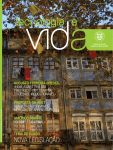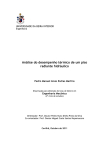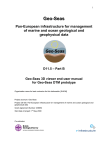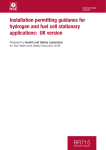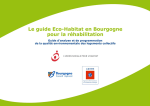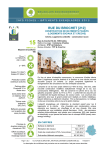Download ÉcoTerra Home - NachhaltigWirtschaften.at
Transcript
ÉcoTerra Home Net Zero Energy Building Overview The EcoTerra house is a prefabricated detached house built in a wooded area in Eastman, Quebec. The house aims at fulfilling the objectives of the EQuilibrium initiative led by Canada's Housing and Mortgage Corporation (CMHC): to provide a healthy, affordable and comfortable living space, while reaching the goal of annual net‐zero energy consumption. Completion Date Winter 2008 This is one of thirty case study factsheets collected by participants in Subtask C of the IEA 'Net Zero Energy Buildings' (NZEBs) research project. Subtask C focuses on documenting and analysing current NZEBs design and technologies. The case studies form the basis of a proposed Source Book describing NZEB Solution Sets and guidelines and documenting monitored performance and lessons learned. Location 9, de la Héronnière Eastman Quebec Architectural Design Concept 84.0521739 Energy Supply (kWh/m².year) Renewable Energy Final: 119.87 Primary: 179.80 Conditioned Floor Area (m²) 230 Occupancy (m2 per Person) 0.01 1.5 125 100 75 50 25 175 0 In the graph Final Energy Demand is the sum of all delivered energy (kWk/m².year) obtained by summing all energy carriers. Final Energy Supply is the sum of all energy generated on site from renewable sources. The Primary Energy Demand and Primary Energy Credit have been calculated based upon the Primary Energy Conversion Factors for each energy carrier for this location. EnergyPlus Model 150 150 Source to Site Conversion Factor (Electricity): Net Floor Area (m²) 230 0 56.03 125 Site Context Open Site 0 100 Building Type Residential 175 Energy Demand (kWh/m².year) Electricity Natural Gas Final: 56.03 Primary: 84.05 75 Climate Challenge Heating Dominated Measured Energy Production and Consumption: These data compare the overall energy consumption with the total energy generated though renewable energy onsite. 50 Climate Challenge Definition Buildings are either cooling dominated, heating dominated or mixed heating and cooling dominated. A building is climate dominated if one of a reference buildings space conditioning processes is 70% or greater of the total space conditioning load. 25 Longitude West 72.3 W 0 Latitude North 45.3 N The house is oriented due south. The footprint is roughly a rectangle with an aspect ratio of about 1.4. The south façade of the house (and hence the roof as well) is longer to receive more direct solar radiation. A family room with large glazing area is located in the south portion of the ground floor. It is the main direct gain zone for passive solar heating. A skylight window with an area of about 1 square meter located above the stairways brings in daylight for the kitchen and dining area. All rooms are equipped with windows except the north portion of the basement, where the mechanical room is located. Large south facing windows and open space architectural layout help improving daylight distribution. The length of the overhangs (e.g. soffit) over the south facing windows was optimized to block most of the direct solar radiation in the summer, but to allow the window to be fully exposed to direct solar radiation in the winter. All the windows are operable. This enables cross ventilation for passive free cooling. Energy Supply (kWh/m².year) Canada Energy Demand (kWh/m².year) Energy Generated/Energy Consumed ‐ Primary Energy Generated/Energy Consumed ‐ Final Climate Analysis The building climate method uses a reference residential building built to the local building code minimum insulation requirements to test the interaction between a building built in a location and the external climatic conditions in that location. Number of Storeys 2 Cost US$/(Net) m² Floor Area 1,500 Cost US$/(Net)m² typical similar building 1,000 This model has been created by the STC participants to assist in the standardised analysis of the performance of this building. It calculates internal temperatures and energy consumption and production. Key to colours: Blue = Outside (sun and wind exposed) Yellow = Ground (floors and basement walls) Purple = Building shading The Climate Challenge for the building designer is HEATING DOMINATED (HD) if the green bars meet between 70 and 100%; it is COOLING DOMINATED (CD) if they meet between 0 and 30%; it is MIXED HEATING AND COOLING (HCD) if they meet between 30 and 70%. Grey = Site shading (ground surfaces) For more information http://www.cmhc‐schl.gc.ca Google earth N/A The icons at the end of each section provide a visual key for the reader who wants to quickly organize all the case studies. They symbolically summarize the individual technology solution sets used in each building. Please see the key to the right for more information H ‐ Heating L ‐ Lighting V ‐ Ventilation C ‐ Cooling P ‐ Plug Load W ‐ Water Heating E ‐ Energy Export Passive Approaches: Passive design techniques or solutions are design measures that require no direct purchased energy input. These design measures include optimisation of solar energy collection, storage and shading, plus natural ventilation and advanced day lighting measures. The information below is organised under headings in the case study database. Where a field is blank it is because the building design team decided that the NZEB design solution set of passive measures for this climate did not need to include this particular measure. Construction Heat Flow (W/ºC) Walls ‐ Construction Elements Facing Solar Noon U‐value (W/m² ºC) 0.16 Solar Absorptivity 0.70 High resistance to heat flow (high R‐ value, low U‐value) is important in climate where energy using services are used to maintain a large temperatures difference between indoors and outdoors. Wood siding, BASF Walltite, Neopor and Enertite insulation U‐value (W/K) Solution Sets are: A set of passive, energy efficiency, and/or renewable energy solutions used to mitigate or lessen the building challenges and achieve the design goal. Heat Flow % Building Challenge Solution Set ‐ The set of solutions used to lower the energy needed by a particular building challenge. Roof 11% 0.16 East U‐value (W/m² ºC) Solar Absorptivity 0.16 0.70 Wall 0.16 21% Whole Building Solution Set ‐ The set of solutions used to lower the energy consumption of the whole building. Window Heat Flow (W/K) 147W/K 1.18 27% Wood siding, BASF Walltite, Neopor and Enertite insulation Floor 41% 0.680 Facing Polar Direction U‐value (W/m² ºC) 0.16 Solar Absorptivity 0.70 Wood siding, BASF Walltite, Neopor and Enertite insulation West U‐value (W/m² ºC) Solar Absorptivity 0.16 0.70 Wood siding, BASF Walltite, Neopor and Enertite insulation Roofs U‐value (W/m² ºC) Solar Absorptivity 0.16 0.80 Cathedral ceiling and attic type of roof Ground floor U‐value (W/m² ºC) Cooling Sunshading There are overhangs over the south facing windows that block most of the direct solar radiation in the summer season. Thermal Mass Natural Ventilation The hollow‐core concrete slab of the basement is actively charged Passive cooling is promoted with all the windows being operable to with the thermal energy coming from the BIPV/T roof, but discharges allow cross ventilation. its energy passively. Heat Recovery There is a drain water heat recovery system to recover part of the heat of the water coming down the shower drain. 0.68 Floor is below‐grade Windows ‐ Construction Elements Solar Noon U‐value (W/m² ºC) 1.18 g‐value 0.53 Argon‐filled, triple‐glazed, low‐e coating East U‐value (W/m² ºC) g‐value Heating Thermal Mass A concrete floor and half‐wall in the south facing zone store solar energy passively. 1.176 0.532 Daylight Systems Skylight and south‐facing windows A skylight window located above the stairways brings in daylight for the kitchen and dining area. All rooms are equipped with windows except the north portion of the basement where the mechanical room is located. Large south facing windows and open space architectural layout help to improve daylight distribution. Window Distribution Information Distribution of Window Areas per Façade In Passive design, the orientation of the windows and their size has an extreme effect on the heating, cooling and the daylight harvesting potential of the building. This graph enables simple comparison of these properties for each climate and building type. Façade Porosity ‐ Percentage of Openings per Facade In Passive Design, the orientation of the openings for Natural Ventilation is a response to the wind and the site. This graph enables a simple comparison of the porosity of each façade for each climate and building type. Argon‐filled, triple‐glazed, low‐e coating Polar Direction U‐value (W/m² ºC) g‐value North Facade North Facade 80% East Façade 70% South Façade 60% West Façade50% 1.18 0.53 Argon‐filled, triple‐glazed, low‐e coating West U‐value (W/m² ºC) g‐value 1.18 0.53 West Façade 40% 30% 20% 10% 0% North Facade 60% 1% 17% 40% 9% North Facade 50% East Façade 40% South Façade 1% 11% 26% West Façade 20% 6% 30% East Façade West Façade 10% 0% East Façade Argon‐filled, triple‐glazed, low‐e coating As Built Air permeability is the total building air leakage (m 3 .h ‐1 ) per m 2 of building envelope at a reference pressure difference of 50 Pa. 0 1.611158192 Compactness (m‐1) 0.53 South Façade South Façade Optimised Floor Plan Thermal Zoning Improved/Advance d Envelope Advanced Glazing Advanced Day lighting Sun Shading Natural Ventilation Evaporative Cooling Passive Solar Heat Gain Thermal Chimney Energy Efficiency Systems: Energy efficient technologies are specific equipment and appliances that focus on reducing the use of energy, in the building, through more efficient means. These energy efficient technologies are used in harmony with the passive design to lower the overall energy consumption of the building. The information below is organised under headings in the case study database. Where a field is blank it is because the building design team decided that the NZEB design solution set of energy efficient Systems for this climate did not need to include this particular system. Innovative Technologies The information below is organised under headings in the case study database. Where a field is blank it is because the building design team decided that the NZEB design solution set of energy efficient Systems for this climate did not need to include this particular technology. System Design Parameters Outside Air Requirements per Person (L/s‐p) 12.5 Artificial Lighting Power Density Installed (W/m²) : Unknown Appliances / Plug Loads Power Density Installed (W/m²) : Computer Network Power Density Installed (W/m²) : Datacentre ? Unknown No Internal Environmental Systems and Domestic Hot Water Energy Reduction Measures for Plug Loads and Appliances Most plug loads and appliances are energy‐ efficient. Energy Storage The basement hollow‐core slab stores the heat from the BIPV/T roof preheated air (heating season) and the coolness from the night outdoor air (cooling season). Concrete floor and half‐wall in the south facing zone ensure passive storage of solar gains Other The BIPV/T roof consists of amorphous silicon PV laminates directly attached to a metal roof, with air passing under the metal to recover heat. This heat is used for both space or water heating. This section describes how the design team has provided for the internal space conditioning. Central systems place the heating, cooling and ventilation equipment in a separate space from the occupied rooms. The heating or cooling of the rooms requires a distribution system taking heat to or away from the occupied rooms using water (hydronic) or air. Distributed systems have separate heating, cooling and possibly ventilation equipment installed for each space. Cooling Central Plant Distributed Plant Openable Windows Ceiling Fans Hydronic distribution Air distribution No No See Passive Systems Yes No Yes no No No Yes Description Cooling is achieved with a geothermal heat pump and pre‐cooling of the hollow‐core slab in the basement. There is also automatic control of th awnings. Description Heating is provided by the BIPV/T roof and a geothermal heat pump with back‐up electrical element. The BIPV/T roof is coupled with a hollow‐core ventilated concrete slab in the basement for space heating, an air‐to‐water heat exchanger for DHW and the clothes dryer. Ventilation System Heat Recovery Type Central Air supply Local Air Recirc plus Central Fresh Air DHW ‐ Domestic Hot Water Solar? Waste Water Heat Recovery? Gas? Electrical? Other? (Less than 200 words:) Yes Yes No Description The house has a heat recovery ventilator (HRV). HVAC Systems Space heating is provided by geothermal heat pump and a BIPV/T roof. This BIPV/T system is coupled with a hollow‐core ventilated concrete slab located in the basement and an air‐to‐water heat exchanger to provide domestic hot water. Heating Central Plant Distributed Plant Hydronic distribution Air distribution Yes Yes Yes No No Description DHW is supplied by the BIPV/T roof (through an air‐to‐water heat exchanger), the heat pump desuperheater, a drain water heat recovery unit and back‐up electricity. Control Systems The critical feature of a successful ultra low energy building is the user interaction. Without control systems that are responsive to user needs and easily understood successful operation is extremely difficult. Artificial Lighting Lighting Description HVAC Description The user interface is located a the entrance. The heating/cooling schedules and setpoints can be adjusted by the user. Computer Management Energy Storage Latent Storage? Fuel Cell? Compressed Air? User Interactions User Manual Provided? No No No Description There is a user interface in the house to indicate weather and the PV system energy production. Control of Systems A commercial system based on the BACNet protocol is used to manage the BIPV/T collector, exterior motorized awnings and heat pump. Energy Efficient Lighting Advanced Lighting Controls Efficient Office Equipment Efficient Appliances Efficient HVAC Equipment No Earth Tube Heat Exchanger Thermal Storage Hot Water Conservation Radiant Structure Monitoring & LoadManagem. Heat Recovery Design Team Energy Supply and Integration of Renewable Energy: “By definition, a renewable energy source is a fuel source that can be replenished in a short amount of time. (American Society Of Heating, Refridgerating and Air‐Conditioning Engineers, 2006)” Through the use of these replenishing energy sources, the annual energy demand of an already low‐energy building can be offset through the renewable energy generation. Renewable energy sources are converted to energy using renewable energy generation technologies or solutions. The information below is organised under headings in the case study database. Where a field is blank it is because the building design team decided that the NZEB design solution set of energy supply and integration of renewable energy for this climate did not need to include this particular measure. Engineer Civil Name Concordia University (Andreas Athienitis) Address 1455 Maisonneuve W, H3G 1M8 email [email protected] Electricity Production Web Address www.bcee/index.php/Dr._A._Athienitis.htm Engineer MEP Name Address email Web Address Photovoltaic (PV) Building Integrated PV? Ground mounted Roof mounted Position Tilt (angle) Azimuth Technology Nominal Power (kWp) Area (m²) Yield (kWh/m².year) Expected generation (kWh) Measured generation (kWh) YES NO YES Fixed 30 0 Amorphous silicone 2.9 45 43 Engineer Structural Name Address email Web Address Solar Water Heating Hot Water Solar Thermal Technology Position Area (m²) Production (kWh/m².year) Annual % of Hot Water Yes Heat recovery from BIPV 30 deg Tilt, 0 deg azimuth 45 n/a n/a Architect Name Masa Noguchi Address Email Production of Heating and Cooling [email protected] Heating Equipment Technology Others BIPV/T air Ground / Water Source Heat Pump Two‐stage Power Efficiency (%) Production (kWh/m².yr) Annual % of Heating n/a n/a 328.9 n/a 10.5 kW COP of 4.2 at full load 2530.0 Web Address Builder/Contractor Name Maison Alouette Address Email Cooling Equipment Web Address http://www.maisonalouette.com Funding Source and Type of Funding The house was built by Alouette Homes with support from the Canadian Solar Buildings Research Network, Canada's Mortgage and Housing Corporation (CMHC), Natural Resources Canada (NRC ) H d Q b dR l Principal Actors This house was developed by Alouette Homes and a Concordia University team as part of Canada's Mortgage and Housing Corporation (CMHC) EQuilibrium initiative. Heat Pump Ground-source, two-stage Technology Power Efficiency (%) Production (kWh/m².year) Annual % of Cooling 11.1 kW ER of 19.8 at full load 115 n/a This graph shows the expected proportion of generation (kWh/m²) of energy produced by the various renewable energy sources based on design calculations. Solar heating Heating energy production Cooling energy production Energy produced from Photovoltaic Panels Energy produced from on site Wind Turbines Hybrid energy production Author Contact Véronique Delisle Photovoltaic (PV Wind Hot Water Heating Cooling Hybrid #VALUE! 0 n/a 2858.9 115.00 0 email Veronique.Delisle@nrcan‐rncan.gc.ca PV Array Onsite Wind Turbine Boiler CHP Use of offsite Green Solar Thermal Hot Power Water Solar Thermal Space Heating Solar Cooling System This project has been organised under the framework of two International Energy Agency implementing agreements: Solar Heating and Cooling and Energy Conservation in Buildings and Community References Systems. For more information please American Society of Heating, Refridgerating and Air‐Conditioning Engineers. Ashrae Green Guide: The Design, Construction, and Operating of Sustainable Buildings USA: Elsevier 2006. visit: www.iea‐shc.org/task40 Belleri, Annamaria, Assunta Napolitano, and Roberto Lollini. "Net Zeb Evaluation Tool ‐ User Guide " (2012). PV/Thermal Array ENERPOS Net Zero Energy Building Overview ENERPOS is the first Net ZEB of the French overseas departments in tropical climates. The building has been designed with priority given to the passive components such as cross natural ventilation and solar shading. In terms of energy use, it consumes one seventh of the average for university buildings in Reunion Island and produces seven times its consumption by BIPV roofs. The building has a high level of monitoring with min by min data separated by end use. Completion Date Construction completed August 2008 Location 40 avenue de Soweto Saint‐Pierre Reunion Island Architectural Design Concept Conditioned Floor Area (m²) 681 Occupancy (m2 per Person) 0.1 11602.30 38287.59 Energy Supply (kWh/m².year) Renewable Energy Final: 115 Primary: 380 3.3 175 150 125 100 75 50 25 250 225 200 175 0 In the graph Final Energy Demand is the sum of all delivered energy (kWk/m².year) obtained by summing all energy carriers. Final Energy Supply is the sum of all energy generated on site from renewable sources. The Primary Energy Demand and Primary Energy Credit have been calculated based upon the Primary Energy Conversion Factors for each energy carrier for this location. EnergyPlus Model 200 150 Source to Site Conversion Factor (Electricity): 225 125 Net Floor Area (m²) 739 0 100 Site Context Suburban Site ‐ single family houses 1‐2 storey spaced 3‐5m apart 0 75 Building Type Non‐residential_Educational 250 Energy Demand (kWh/m².year) Electricity Final: 11602 Primary: 38288 50 Climate Challenge Cooling Dominated Measured Energy Production and Consumption: These data compare the overall energy consumption with the total energy generated though renewable energy onsite. 25 Climate Challenge Definition Buildings are either cooling dominated, heating dominated or mixed heating and cooling dominated. A building is climate dominated if one of a reference buildings space conditioning processes is 70% or greater of the total space conditioning load. 0 Longitude West 55° 29' Passive techniques: Cross natural ventilation (2 building wings orientated to be exposed to the summer thermal breezes), native plants around the building Solar shading of all windows and walls Insulation of the roof (+ BIPV over‐roof) Energy Supply (kWh/m².year) France Latitude South 21° 20' This is one of thirty case study factsheets collected by participants in Subtask C of the IEA 'Net Zero Energy Buildings' (NZEBs) research project. Subtask C focuses on documenting and analysing current NZEBs design and technologies. The case studies form the basis of a proposed Source Book describing NZEB Solution Sets and guidelines and documenting monitored performance and lessons learned. Energy Demand (kWh/m².year) Energy Generated/Energy Consumed ‐ Primary Energy Generated/Energy Consumed ‐ Final Climate Analysis The building climate method uses a reference non‐residential building built to the local building code minimum insulation requirements to test the interaction between a building built in a location and the external climatic conditions in that location. Number of Storeys Cost US$/(Net) m² Floor Area 4,581 Cost US$/(Net) m² typical similar building This model has been created by the STC participants to assist in the standardised analysis of the performance of this building. It calculates internal temperatures and energy consumption and production. Key to colours: Blue = Outside (sun and wind exposed) Yellow = Ground (floors and basement walls) Purple = Building shading The Climate Challenge for the building designer is HEATING DOMINATED (HD) if the green bars meet between 70 and 100%; it is COOLING DOMINATED (CD) if they meet between 0 and 30%; it is MIXED HEATING AND COOLING (HCD) if they meet between 30 and 70%. Grey = Site shading (ground surfaces) Web Address http://lpbs.univ‐reunion.fr/enerpos For more information: http://tinyurl.com/Enerpos‐FR‐RE The icons at the end of each section provide a visual key for the reader who wants to quickly organize all the case studies. They symbolically summarize the individual technology solution sets used in each building. Please see the key to the right for more information H ‐ Heating L ‐ Lighting V ‐ Ventilation C ‐ Cooling P ‐ Plug Load W ‐ Water Heating E ‐ Energy Export Passive Approaches: Passive design techniques or solutions are design measures that require no direct purchased energy input. These design measures include optimisation of solar energy collection, storage and shading, plus natural ventilation and advanced day lighting measures. The information below is organised under headings in the case study database. Where a field is blank it is because the building design team decided that the NZEB design solution set of passive measures for this climate did not need to include this particular measure. Construction Heat Flow (W/ºC) Walls ‐ Construction Elements Facing Solar Noon U‐value (W/m² ºC) 3.79 Solar Absorptivity 0.40 High resistance to heat flow (high R‐ value, low U‐value) is important in climate where energy using services are used to maintain a large temperatures difference between indoors and outdoors. Concrete (20 cm) + Solar shading U‐value (W/ºC) Solution Sets are: A set of passive, energy efficiency, and/or renewable energy solutions used to mitigate or lessen the building challenges and achieve the design goal. Heat Flow % Building Challenge Solution Set ‐ The set of solutions used to lower the energy needed by a particular building challenge. Roof 0% 0.27 East U‐value (W/m² ºC) Solar Absorptivity 0.90 0.40 Wall 3.79 77% Whole Building Solution Set ‐ The set of solutions used to lower the energy consumption of the whole building. Window Heat Flow (W/K) 1620W/K 5.90 23% Concrete (20 cm) + Insulation (… cm of mineral wool) + Wooden siding Floor 0% 1.08 Facing Polar Direction U‐value (W/m² ºC) 3.79 Solar Absorptivity 0.40 Heating Cooling Natural Ventilation Porosity of main facade : 30% (PERENE requirement : 20%), louvers Concrete (20 cm) + Solar shading West U‐value (W/m² ºC) Solar Absorptivity 0.90 0.40 Green Roof/Façade Vegetalisation of the facade to avoid overheat of entering air, vegetalised patio on top of an underground parking, use of native plants to avoid plant care Concrete (20 cm) + Insulation (… cm of mineral wool) + Wooden siding Roofs U‐value (W/m² ºC) Solar Absorptivity 0.27 0.80 Sunshading Main facades (North and South) are solar protected with wooden strips that were sized with SketchUp and optimized with daylight simulation (Daysim) Concrete + Insulation (10 cm of polystyrene) + BIPV over‐roof Ground floor U‐value (W/m² ºC) 1.08 Daylight Systems High value of porosity combined with solar shadings Daylight autonomy in classrooms in about 90% Windows ‐ Construction Elements Solar noon U‐value (W/m² ºC) 5.90 0.87 g‐value Window Distribution Information Saint‐Gobain SGG STADIP Clear Distribution of Window Areas per Façade Façade Porosity ‐ Percentage of Openings per Façade East U‐value (W/m² ºC) g‐value In Passive design, the orientation of the windows and their size has an extreme effect on the heating, cooling and the daylight harvesting potential of the building. This graph enables simple comparison of these properties for each climate and building type. In Passive Design, the orientation of the openings for Natural Ventilation is a response to the wind and the site. This graph enables a simple comparison of the porosity of each façade for each climate and building type. Polar direction U‐value (W/m² ºC) g‐value North Facade 26% East Façade 0% South FaçadeNorth Facade 21% 80% West Façade70% 1% 5.90 0.87 Saint‐Gobain SGG STADIP Clear West U‐value (W/m² ºC) g‐value West Façade Air permeability (m³/m²h@50pa) Air permeability is the total building air leakage (m3.h‐1) per m2 of building envelope at a reference pressure difference of 50 Pa. 60% 50% 40% 30% 20% 10% 0% North Facade 29% East Façade North Facade 0% 60% South Façade 29% 50% West Façade 1% East Façade West Façade 40% 30% 20% 10% 0% East Façade South Façade South Façade As Built Optimised Floor Plan Compactness (m‐1) Thermal Zoning Improved/Advance d Envelope Advanced Glazing Advanced Day lighting Sun Shading Natural Ventilation Evaporative Cooling Passive Solar Heat Thermal Chimney Gain Energy Efficiency Systems: Energy efficient technologies are specific equipment and appliances that focus on reducing the use of energy, in the building, through more efficient means. These energy efficient technologies are used in harmony with the passive design to lower the overall energy consumption of the building. The information below is organised under headings in the case study database. Where a field is blank it is because the building design team decided that the NZEB design solution set of energy efficient Systems for this climate did not need to include this particular system. Innovative Technologies The information below is organised under headings in the case study database. Where a field is blank it is because the building design team decided that the NZEB design solution set of energy efficient Systems for this climate did not need to include this particular technology. System Design Parameters Outside Air Requirements per Person (L/s‐p) xxx Artificial Lighting Power Density Installed (W/m²) : 3,7 W/m² Appliances / Plug Loads Power Density Installed (W/m²) : Computer Network Power Density Installed (W/m²) : Datacentre ? 1.45374449 No 16 Internal Environmental Systems and Domestic Hot Water Energy Reduction Measures for Plug Loads and Appliances eg. Elevator : reduction of half the consumption with stand‐by mode on (thanks to the measured data) This section describes how the design team has provided for the internal space conditioning. Central systems place the heating, cooling and ventilation equipment in a separate space from the occupied rooms. The heating or cooling of the rooms requires a distribution system taking heat to or away from the occupied rooms using water (hydronic) or air. Distributed systems have separate heating, cooling and possibly ventilation equipment installed for each space. Energy Storage Cooling Central Plant Distributed Plant Openable Windows Ceiling Fans Hydronic distribution Air distribution Yes No See Passive Systems Yes No Yes Heating Central Plant Distributed Plant Hydronic distribution Air distribution Yes No No No Description VRV air‐conditioning (only for offices & computer rooms) ‐ cooling period: 6 weeks/y Description Ventilation System Heat Recovery Type Central Air supply Local Air Recirc plus Central Fresh Air DHW ‐ Domestic Hot Water Solar? Waste Water Heat Recovery? Gas? Electrical? Other? Other Ceiling fans in all rooms and offices (1/10m²) No Yes Yes Description Description HVAC Systems VRV system for AC + split systems in the technical rooms Control Systems The critical feature of a successful ultra low energy building is the user interaction. Without control systems that are responsive to user needs and easily understood successful operation is extremely difficult. Artificial Lighting Offices : mood lighting (100 Lux) + LED desk lamps (>300 Lux on the work area) 3,7 W/m² Classrooms : 7,3 W/m² Lighting BMS for exterior lighting (timetable) + 2 hours timers for interior lighting in the classrooms. HVAC BMS: timetable, individual control in each offices of the set temperature Energy Storage Latent Storage? Fuel Cell? Compressed Air? User Interactions User Manual Provided? Computer Management Theory : computers delocalized in a technical room ‐ not realized yet Description Users can control the ciling fans (nearly one ceiling fan/ pers in the offices) and all windows are openable manually. The lighting is also manual except for the classrooms where there is a 2 hours timer in case the users forget to turn off the lights. The VRV system functions on timetable. Control of Systems Building Management System Energy Efficient Lighting Advanced Lighting Controls Efficient Office Equipment yes Efficient Appliances Efficient HVAC Equipment Earth Tube Heat Exchanger Thermal Storage Hot Water Conservation Radiant Structure Monitoring & LoadManagem. Heat Recovery Design Team Engineer Civil Name INSET Address 8 rue Henri Cornu BP 12005, 97801 Saint Denis, FRANCE Email [email protected] Web Address http://www.inset.fr/ Engineer MEP Name RTI Address Email Web Address Energy Supply and Integration of Renewable Energy: “By definition, a renewable energy source is a fuel source that can be replenished in a short amount of time. (American Society Of Heating, Refridgerating and Air‐Conditioning Engineers, 2006)” Through the use of these replenishing energy sources, the annual energy demand of an already low‐energy building can be offset through the renewable energy generation. Renewable energy sources are converted to energy using renewable energy generation technologies or solutions. The information below is organised under headings in the case study database. Where a field is blank it is because the building design team decided that the NZEB design solution set of energy supply and integration of renewable energy for this climate did not need to include this particular measure. Electricity Production Photovoltaic (PV) Building Integrated PV? Ground mounted Roof mounted Position Tilt (angle) Azimuth Technology Nominal Power (kWp) Area (m²) Yield (kWh/m².year) Expected generation (kWh) Measured generation (kWh) Yes Wind Turbine The PV panels are integrated Position No Number of Turbine yes Technology Fixed Nominal Power (kWp) 9° Energy Production (kWh/m².year) PV1 : ‐166° North / PV2 : 14° North Polycristalline cells 50 PV1 : 219 m² / PV2 : 146 m² >> total: 365m² 70 77000.00 50000.00 Engineer Structural Name Address Email Web Address Solar Water Heating Combined (Cooling) Heat and Power Hot Water Solar Thermal Technology Position Area (m²) Production (kWh/m².year) Annual % of Hot Water Combined (Cooling) Heat and Power Type Fuel Efficiency (%) Electricity Water Heating Space Heating Cooling Production (kWh/m².year) Electricity Water Heating Space Heating Cooling Architect Name Atelier FAESSEL BOEHE Address 18 CD4 – SAVANNAH, 97460 SAINT‐PAUL, France Email [email protected] Renewable Production of Heating and Cooling Heating Equipment There is no active heating system installed in the building. Web Address Technology Builder/Contractor Name LEON GROSSE Address r Guadeloupe, 97490 SAINT DENIS, France Power Efficiency (%) Production (kWh/m².yr) Annual % of Heating Email Cooling Equipment There is no active cooling system installed in the building. Web Address Technology Funding Source and Type of Funding General council of La Reunion (4M€) ; City of Saint Pierre (800 000€ ; land contribution) ; Regional council of La Reunion Power Efficiency (%) Production (kWh/m².year) Annual % of Cooling This graph shows the expected proportion of generation (kWh/m²) of energy produced by the various renewable energy sources based on design calculations. Principal Actors University of La Reunion (client) ; Thermal Engineer Office Hot water heating Heating energy production Cooling energy production Energy produced from Photovoltaic Panels Energy produced from on site Wind Turbines Hybrid energy production Authors François Garde / Aurélie Lenoir Photovoltaic (PV Wind Hot Water Heating Cooling Hybrid 68 0 0 0 0.00 0 Email garde@univ‐reunion.fr / aurelie.lenoir@univ‐reunion.fr PV Array Onsite Wind Turbine Boiler CHP Use of offsite Green Power Solar Thermal Hot Water Solar Thermal Space Heating Solar Cooling System This project has been organised under the framework of two International Energy Agency implementing agreements: Solar Heating and Cooling and Energy Conservation in Buildings and References American Society of Heating, Refridgerating and Ait‐Conditioning Engineers. Ashrae Green Guide: The Design, Construction, and Operating of Sustainable Buildings USA: Elsevier 2006. Community Systems. For more information please visit: www.iea‐ Belleri, Annamaria, Assunta Napolitano, and Roberto Lollini. "Net Zeb Evaluation Tool ‐ User Guide " (2012). shc.org/task40 PV/Thermal Array Kleehäuser Net Zero Energy Building Overview Passive house with very low heat demand following the idea of the 2000 Watt society. Intensive use of differnet renewables energy sources and CHP Completion Date Jun‐05 This is one of thirty case study factsheets collected by participants in Subtask C of the IEA 'Net Zero Energy Buildings' (NZEBs) research project. Subtask C focuses on documenting and analysing current NZEBs design and technologies. The case studies form the basis of a proposed Source Book describing NZEB Solution Sets and guidelines and documenting monitored performance and lessons learned. Location Paul‐Klee Str. 6 79100 Freiburg Baden‐Württemberg Architectural Design Concept Conditioned Floor Area (m²) 2520 Occupancy (m2 per Person) 0.029761905 152.273 Energy Supply (kWh/m².year) Renewable Energy Final: 56.94 Primary: 148.04 2.6 100 75 50 25 0 In the graph Final Energy Demand is the sum of all delivered energy (kWk/m².year) obtained by summing all energy carriers. Final Energy Supply is the sum of all energy generated on site from renewable sources. The Primary Energy Demand and Primary Energy Credit have been calculated based upon the Primary Energy Conversion Factors for each energy carrier for this location. EnergyPlus Model 125 175 Source to Site Conversion Factor (Electricity): 150 150 Net Floor Area (m²) 2520 0 101.98 125 Site Context Suburban Site ‐ single family houses 1‐2 storey spaced 3‐5m apart 0 100 Building Type Residential 175 Energy Demand (kWh/m².year) Electricity Natural Gas Final: 26.73 75.25 Primary: 69.50 82.775 75 Climate Challenge Heating & Cooling Dominated Measured Energy Production and Consumption: These data compare the overall energy consumption with the total energy generated though renewable energy onsite. 50 Climate Challenge Definition Buildings are either cooling dominated, heating dominated or mixed heating and cooling dominated. A building is climate dominated if one of a reference buildings space conditioning processes is 70% or greater of the total space conditioning load. 25 Longitude West 7°49'18.93" 0 Latitude North 47°58'36.47" The two buildings have a very compact structure to lower the heated volume. Hence the stairs are outside of this volume (acces balconies). The surface is very good insulated and triple glazed windows are used. The passive solar design is supported by an assymetric window arrangement. Extensively glazed facades facing south optimise passive solar energy gains in winter. Cantilevered balconies oriented towards the south and extending up to two meters provide shade and prevent overheating in summer. The remaining facades feature a smaller degree of window surfaces. The layout follows the same principle: living spaces are generally oriented towards the south and other areas are on the northern side of the buildings. Energy Supply (kWh/m².year) Germany Energy Demand (kWh/m².year) Energy Generated/Energy Consumed ‐ Primary Energy Generated/Energy Consumed ‐ Final Climate Analysis The building climate method uses a reference residential building built to the local building code minimum insulation requirements to test the interaction between a building built in a location and the external climatic conditions in that location. Number of Storeys 3 and 5 Cost US$/(Net) m² Floor Area 1,923 Cost US$/(Net) m² typical similar building This model has been created by the STC participants to assist in the standardised analysis of the performance of this building. It calculates internal temperatures and energy consumption and production. Key to colours: Blue = Outside (sun and wind exposed) Yellow = Ground (floors and basement walls) Purple = Building shading The Climate Challenge for the building designer is HEATING DOMINATED (HD) if the green bars meet between 70 and 100%; it is COOLING DOMINATED (CD) if they meet between 0 and 30%; it is MIXED HEATING AND COOLING (HCD) if they meet between 30 and 70%. Grey = Site shading (ground surfaces) For more information www.kleehaeuser.de Google earth http://tinyurl.com/Kleehauser The icons at the end of each section provide a visual key for the reader who wants to quickly organize all the case studies. They symbolically summarize the individual technology solution sets used in each building. Please see the key to the right for more information H ‐ Heating L ‐ Lighting V ‐ Ventilation C ‐ Cooling P ‐ Plug Load W ‐ Water Heating E ‐ Energy Export Passive Approaches: Passive design techniques or solutions are design measures that require no direct purchased energy input. These design measures include optimisation of solar energy collection, storage and shading, plus natural ventilation and advanced day lighting measures. The information below is organised under headings in the case study database. Where a field is blank it is because the building design team decided that the NZEB design solution set of passive measures for this climate did not need to include this particular measure. Construction Heat Flow (W/ºC) Walls ‐ Construction Elements Facing Solar Noon U‐value (W/m² ºC) 0.17 Solar Absorptivity High resistance to heat flow (high R‐ value, low U‐value) is important in climate where energy using services are used to maintain a large temperatures difference between indoors and outdoors. On the balcony and porch fronts white fiber cement panels alternate with triple‐ glazed timber frame windows. 0.17 Wall 0.17 Externally reinforced concrete walls or infilled wood stud walls insulated with 30 cm mineral wool. Wood planks or untreated steel plates dress the gables. Facing Polar Direction U‐value (W/m² ºC) 0.17 Solar Absorptivity On the balcony and porch fronts white fiber cement panels alternate with triple‐ glazed timber frame windows. West U‐value (W/m² ºC) Solar Absorptivity 8% 28% Whole Building Solution Set ‐ The set of solutions used to lower the energy consumption of the whole building. Window Heat Flow (W/K) 1128W/K 0.98 51% Floor 13% 0.180 Heating Thermal Mass In some apartments loam buffers moisture Cooling Sunshading South facades are solar protected with balconies and/or blinds Heat Recovery Natural Ventilation Individually controlled air by the ventialtion system ensures a Normal option to open the windows comfortable indoor climate. Directly at each apartment entrance door is a switch that can be used to regulate the air flow individually and in three stages (85%) An improved thermal insulation standard of the distribution pipelines of the ventilation system reduces heat losses 0.18 Thermal envelope of basement is insulated with rigid foam boards. Windows ‐ Construction Elements Solar noon U‐value (W/m² ºC) 0.98 g‐value 0.60 triple glazed windwows East U‐value (W/m² ºC) g‐value Building Challenge Solution Set ‐ The set of solutions used to lower the energy needed by a particular building challenge. 0.11 Reinforced concrete of flat roof is insulated with 30 cm of expanded polystyrene (EPS). Ground floor U‐value (W/m² ºC) Heat Flow % 0.17 Externally reinforced concrete walls or infilled wood stud walls insulated with 30 cm mineral wool. Wood planks or untreated steel plates dress the gables. Roofs U‐value (W/m² ºC) Solar Absorptivity Solution Sets are: A set of passive, energy efficiency, and/or renewable energy solutions used to mitigate or lessen the building challenges and achieve the design goal. Roof 0.11 East U‐value (W/m² ºC) Solar Absorptivity U‐value (W/K) 0.98 0.6 Daylight Systems Windows High value of porosity combined with solar shadings Window Distribution Information Distribution of Window Areas per Façade In Passive design, the orientation of the windows and their size has an extreme effect on the heating, cooling and the daylight harvesting potential of the building. This graph enables simple comparison of these properties for each climate and building type. Façade Porosity ‐ Percentage of Openings per Facade In Passive Design, the orientation of the openings for Natural Ventilation is a response to the wind and the site. This graph enables a simple comparison of the porosity of each façade for each climate and building type. triple glazed windwows Polar direction U‐value (W/m² ºC) g‐value North Facade North Facade 80% East Façade 70% South Façade 60% West Façade50% 0.98 0.60 triple glazed windwows West U‐value (W/m² ºC) g‐value 0.98 0.60 West Façade 40% 30% 20% 10% 0% North Facade 60% 11% 10% 50% 11% North Facade 50% East Façade 40% South Façade 11% 10% 50% West Façade 20% 11% 30% East Façade West Façade 10% 0% East Façade triple glazed windwows As Built Air permeability is the total building air leakage (m 3 .h ‐1 ) per m 2 of building envelope at a reference pressure difference of 50 Pa. 0 0.6 Compactness (m‐1) 0.38 South Façade South Façade Optimised Floor Plan Thermal Zoning Improved/Advance d Envelope Advanced Glazing Advanced Day lighting Sun Shading Natural Ventilation Evaporative Cooling Passive Solar Heat Gain Thermal Chimney Energy Efficiency Systems: Energy efficient technologies are specific equipment and appliances that focus on reducing the use of energy, in the building, through more efficient means. These energy efficient technologies are used in harmony with the passive design to lower the overall energy consumption of the building. The information below is organised under headings in the case study database. Where a field is blank it is because the building design team decided that the NZEB design solution set of energy efficient Systems for this climate did not need to include this particular system. Innovative Technologies The information below is organised under headings in the case study database. Where a field is blank it is because the building design team decided that the NZEB design solution set of energy efficient Systems for this climate did not need to include this particular technology. System Design Parameters Outside Air Requirements per Person (L/s‐p) Indoor air changed 1/2 per hour Artificial Lighting Power Density Installed (W/m²) : Unknown Appliances / Plug Loads Power Density Installed (W/m²) : Computer Network Power Density Installed (W/m²) : Datacentre ? Unknown No No information available Internal Environmental Systems and Domestic Hot Water Energy Reduction Measures for Plug Loads and Appliances Partly efficient appliances, efficient elevator, switcher for the ventilation system in each appartment Energy Storage Thermal buffer storage (3900 l) This section describes how the design team has provided for the internal space conditioning. Central systems place the heating, cooling and ventilation equipment in a separate space from the occupied rooms. The heating or cooling of the rooms requires a distribution system taking heat to or away from the occupied rooms using water (hydronic) or air. Distributed systems have separate heating, cooling and possibly ventilation equipment installed for each space. Cooling Central Plant Distributed Plant Openable Windows Ceiling Fans Hydronic distribution Air distribution Heating Central Plant Distributed Plant Hydronic distribution Air distribution No No Yes No No No Description No cooling plant Yes No No No Description A natural gas‐powered cogeneration plant (capacity 14 kWel / 30 kWth) generates electricity for the own small electricity grid and covers the heat demand of the two houses. 61.2 m² of flat plate collectors feed heat into a small heat grid between the two houses. A solar heat storage has a total volume of 3900 liters. Other Common used refrigerators and washing mashines with hot water tab in cellar rooms Ventilation System Heat Recovery Type Central Air supply Local Air Recirc plus Central Fresh Air DHW ‐ Domestic Hot Water Solar? Waste Water Heat Recovery? Gas? Electrical? Other? Yes Yes Yes Description Ventilation with 85% heat recovery Yes No No Yes Yes Description Solar thermal system and a CHPP HVAC Systems small scale CHP Control Systems The critical feature of a successful ultra low energy building is the user interaction. Without control systems that are responsive to user needs and easily understood successful operation is extremely difficult. Artificial Lighting LEDs and very efficient light bulbs Lighting Description HVAC Description HVAC is controlled by normal systems(related to the CHPP). By a switch in each apartment the air flow can be adjusted (to conserve moisture when absent) no information available because of residential use Computer Management Energy Storage Latent Storage? Fuel Cell? Compressed Air? User Interactions User Manual Provided? No No No Description User related by efficient appliances Control of Systems Building Management System Energy Efficient Lighting Advanced Lighting Controls Efficient Office Equipment Efficient Appliances Efficient HVAC Equipment yes Earth Tube Heat Exchanger Thermal Storage Hot Water Conservation Radiant Structure Monitoring & LoadManagem. Heat Recovery Design Team Engineer Civil Name Solares Bauen, Freiburg Address Emmy‐Noether‐Str.2, 79110 Freiburg email info@solares‐bauen.de Web Address www.solares‐bauen.de Engineer MEP Name solares bauen, Freiburg, Address Emmy‐Noether‐Str.2, 79110 Freiburg email info@solares‐bauen.de Web Address www.solares‐bauen.de Energy Supply and Integration of Renewable Energy: “By definition, a renewable energy source is a fuel source that can be replenished in a short amount of time. (American Society Of Heating, Refridgerating and Air‐Conditioning Engineers, 2006)” Through the use of these replenishing energy sources, the annual energy demand of an already low‐energy building can be offset through the renewable energy generation. Renewable energy sources are converted to energy using renewable energy generation technologies or solutions. The information below is organised under headings in the case study database. Where a field is blank it is because the building design team decided that the NZEB design solution set of energy supply and integration of renewable energy for this climate did not need to include this particular measure. Electricity Production Photovoltaic (PV) Building Integrated PV? Ground mounted Roof mounted Position Tilt (angle) Azimuth Technology Nominal Power (kWp) Area (m²) Yield (kWh/m².year) Expected generation (kWh) Measured generation (kWh) Yes No No Yes Fixed 30° 0° South Polycrstalline cells 23 kWp 202 m² 43 23000 22529 Off-site one ??? 6300 kW 26.52 Engineer Structural Name Address email Web Address Solar Water Heating Hot Water Solar Thermal Technology Position Area (m²) Production (kWh/m².year) Annual % of Hot Water Yes flat plate collectors on the roof 56.4 efficiency measure ca. 70 % natural gaspowered CHP Gas ca. 90 % 0.3 0.3 0.3 0 21 21,48 kWh/m²y 71,51 kWh/m²y see above no Architect Name Common & Gies Architekten, Freiburg Address Kronenstrasse 33, 79100 Freiburg 0.3 Production of Heating and Cooling Email [email protected] Heating Equipment Web Address www.commonarchitekten.de Technology Others natural gaspowered CHP Power Efficiency (%) Production (kWh/m².yr) Annual % of Heating capacity 14 kWel / heat output 30 kWth ca. 90 % 7151.0 0 % because ist natural gas Email [email protected] Cooling Equipment There is no active cooling system installed in the building. Web Address www.kleehaeuser.de/ Technology Builder/Contractor Name assembly Group Baugruppe Kleehäuser Address Paul‐Klee Str. 6, 79100 Freiburg Funding Source and Type of Funding The two buildings were built by a assembly and hence funded completly private. 0 Power Efficiency (%) Production (kWh/m².year) Annual % of Cooling This graph shows the expected proportion of generation (kWh/m²) of energy produced by the various renewable energy sources based on design calculations. Principal Actors Main actor was a building assembly. Engineers forced the project to a zeroHaus‐ certificate (consumptions are equalized by renewables) Solar heating Heating energy production Cooling energy production Energy produced from Photovoltaic Panels Energy produced from on site Wind Turbines Hybrid energy production Author Contact Eike Musall Photovoltaic (PV Wind Hot Water Heating Cooling Hybrid 9 26.52 efficiency mea #VALUE! 0.00 21.48 email emusall@uni‐wuppertal.de PV Array Onsite Wind Turbine Boiler CHP Use of offsite Green Solar Thermal Hot Power Water Solar Thermal Space Heating Solar Cooling System This project has been organised under the framework of two International Energy Agency implementing agreements: Solar Heating and Cooling and Energy Conservation in Buildings and Community References Systems. For more information please American Society of Heating, Refridgerating and Air‐Conditioning Engineers. Ashrae Green Guide: The Design, Construction, and Operating of Sustainable Buildings USA: Elsevier 2006. visit: www.iea‐shc.org/task40 Belleri, Annamaria, Assunta Napolitano, and Roberto Lollini. "Net Zeb Evaluation Tool ‐ User Guide " (2012). PV/Thermal Array Leaf House Net Zero Energy Building Overview The Leaf House inspiration is the Italian rural house an autonomous and sustainable microcosm where every resource was exploited and nothing wasted. Its main features are: North South orientation, high thermal mass boundary walls, and glazed surfaces on the South facade. Transforming a traditional morphology into a Net ZEB, integrating the best available technologies, makes the integration of this building in peripheral areas of our cities easier. Net Floor Area (m²) 477 Conditioned Floor Area (m²) 477 Occupancy (m2 per Person) 0.025 0 73.75 160.045006 Energy Supply (kWh/m².year) Renewable Energy Final: 51.89 Primary: 112.60 Source to Site Conversion Factor (Electricity): 2.2 125 100 75 50 25 0 In the graph Final Energy Demand is the sum of all delivered energy (kWk/m².year) obtained by summing all energy carriers. Final Energy Supply is the sum of all energy generated on site from renewable sources. The Primary Energy Demand and Primary Energy Credit have been calculated based upon the Primary Energy Conversion Factors for each energy carrier for this location. EnergyPlus Model 150 175 Site Context Village, Urban Edge ‐ 2‐5 storey buildings with at most narrow lanes between adjacent buildings and street widths of 20 ‐ 40m 0 150 Building Type Residential 175 Energy Demand (kWh/m².year) Electricity Final: 73.75 Primary: 160.05 125 Climate Challenge Heating & Cooling Dominated Measured Energy Production and Consumption: These data compare the overall energy consumption with the total energy generated though renewable energy onsite. 100 Climate Challenge Definition Buildings are either cooling dominated, heating dominated or mixed heating and cooling dominated. A building is climate dominated if one of a reference buildings space conditioning processes is 70% or greater of the total space conditioning load. 75 Longitude West 13° 04' 03" E 50 Latitude North 43° 28' 43" N Architectural Design Concept The Leaf House is N‐S oriented and presents a compact shape; to increase its thermal performance, the North facade is set into a bank, enhancing thermal exchange with the ground. On the South facade, the glazed surfaces allow for good daylight in the building, and for enhancing the useful solar gains useful in Winter. During the hotter season a large photovoltaic roof, integrated into the envelope protects the building from the sun, by overhanging on the South facade, so as to shadow the upper level of the building (3rd level). The second level is shadowed by a canopy made out of 7 thermal modules; the overhang of the balcony at the second level, provides shadow to the first level. These overhangs have been designed using dynamic simulations which have been used to design the optimized control of the building services through the building automation system, reducing not only the energy consumption of the building but its impact on the grid. 25 Italy 0 Location Petrarca (via F. Petrarca) Rosora Ancona This is one of thirty case study factsheets collected by participants in Subtask C of the IEA 'Net Zero Energy Buildings' (NZEBs) research project. Subtask C focuses on documenting and analysing current NZEBs design and technologies. The case studies form the basis of a proposed Source Book describing NZEB Solution Sets and guidelines and documenting monitored performance and lessons learned. Energy Supply (kWh/m².year) Completion Date Jun‐05 Energy Demand (kWh/m².year) Energy Generated/Energy Consumed ‐ Primary Energy Generated/Energy Consumed ‐ Final Climate Analysis The building climate method uses a reference residential building built to the local building code minimum insulation requirements to test the interaction between a building built in a location and the external climatic conditions in that location. Number of Storeys Cost US$/(Net) m² Floor Area 943,600 Cost US$/(Net) m² typical similar building 704,200 This model has been created by the STC participants to assist in the standardised analysis of the performance of this building. It calculates internal temperatures and energy consumption and production. Key to colours: Blue = Outside (sun and wind exposed) Yellow = Ground (floors and basement walls) Purple = Building shading The Climate Challenge for the building designer is HEATING DOMINATED (HD) if the green bars meet between 70 and 100%; it is COOLING DOMINATED (CD) if they meet between 0 and 30%; it is MIXED HEATING AND COOLING (HCD) if they meet between 30 and 70%. Grey = Site shading (ground surfaces) For more information http://www.leafcommunity.com/?page_id =5&lang=en The icons at the end of each section provide a visual key for the reader who wants to quickly organize all the case studies. They symbolically summarize the Google earth individual technology solution sets used in each http://tinyurl.com/LeafHouseAlbum building. Please see the key to the right for more information H ‐ Heating L ‐ Lighting V ‐ Ventilation C ‐ Cooling P ‐ Plug Load W ‐ Water Heating E ‐ Energy Export Passive Approaches: Passive design techniques or solutions are design measures that require no direct purchased energy input. These design measures include optimisation of solar energy collection, storage and shading, plus natural ventilation and advanced day lighting measures. The information below is organised under headings in the case study database. Where a field is blank it is because the building design team decided that the NZEB design solution set of passive measures for this climate did not need to include this particular measure. Construction Heat Flow (W/ºC) Walls ‐ Construction Elements Facing Solar Noon U‐value (W/m² ºC) 0.15 Solar Absorptivity High resistance to heat flow (high R‐ value, low U‐value) is important in climate where energy using services are used to maintain a large temperatures difference between indoors and outdoors. 2cm Plaster, 30cm Poroton Brick, 18cm Polystyrene Rofix EPS 100, 2cm Plaster U‐value (W/K) Solution Sets are: A set of passive, energy efficiency, and/or renewable energy solutions used to mitigate or lessen the building challenges and achieve the design goal. Heat Flow % Building Challenge Solution Set ‐ The set of solutions used to lower the energy needed by a particular building challenge. Roof 26% 0.25 East U‐value (W/m² ºC) Solar Absorptivity 0.15 Wall 0.15 30% Whole Building Solution Set ‐ The set of solutions used to lower the energy consumption of the whole building. Window Heat Flow (W/K) 324W/K 0.86 17% Floor 27% 0.410 Facing Polar Direction U‐value (W/m² ºC) 0.15 Solar Absorptivity 124 of them below grade West U‐value (W/m² ºC) Solar Absorptivity 0.15 Roofs U‐value (W/m² ºC) Solar Absorptivity 0.25 Cooling Sunshading The roof, solar thermal panels and the balcony behave like solar shields Sunspaces Green Roof/Façade Wide windows on the southern facade allow solar radiation to heat up Ventilated roof reduces the solar loads during summer the building 3x1cm Plasterboard Pregyplac, 10cm woodfibre, 10 cm rockwool, 4cm airspace, 2cm Pinewood Ground floor U‐value (W/m² ºC) Heating Thermal Mass Walls and floors have an high thermal mass Ground Cooling Preconditioning in an underground duct of the fresh air Heat Recovery Preconditioning in an underground duct of the fresh air 0.41 2cm ceramic tile, 5cm concrete, 4cm polyurethane, 5cm concrete, 0.5cm bitumen, 20cm concrete, 19cm air, 11.80cm gravel Windows ‐ Construction Elements Solar noon U‐value (W/m² ºC) 0.86 g‐value 0.61 Daylight Systems Solar tubes The two apartments of the ground floor and the two apartments of the first floor have a bathroom not provided with windows: solar tubes allows natural light to light these rooms Internorm, Edition, double glazing filled with argon Distribution of Window Areas per Façade In Passive design, the orientation of the windows and their size has an extreme effect on the heating, cooling and the daylight harvesting potential of the building. This graph enables simple comparison of these properties for each climate and building type. East U‐value (W/m² ºC) g‐value 0.86 0.61 Polar direction U‐value (W/m² ºC) g‐value 0.86 0.61 West U‐value (W/m² ºC) g‐value 0.86 0.61 Window Distribution Information North Facade North Facade 80% East Façade 70% South Façade 60% West Façade50% West Façade As Built Air permeability is the total building air leakage (m 3 .h ‐1 ) per m 2 of building envelope at a reference pressure difference of 50 Pa. 0 1.91 Compactness (m‐1) 0.47 40% 30% 20% 10% 0% Façade Porosity ‐ Percentage of Openings per Facade In Passive Design, the orientation of the openings for Natural Ventilation is a response to the wind and the site. This graph enables a simple comparison of the porosity of each façade for each climate and building type. North Facade 60% 4% 6% 24% 6% Thermal Zoning Improved/Advance d Envelope 4% 6% 24% West Façade 20% 6% 30% East Façade West Façade 10% 0% East Façade South Façade South Façade Optimised Floor Plan North Facade 50% East Façade 40% South Façade Advanced Glazing Advanced Day lighting Sun Shading Natural Ventilation Evaporative Cooling Passive Solar Heat Gain Thermal Chimney Energy Efficiency Systems: Energy efficient technologies are specific equipment and appliances that focus on reducing the use of energy, in the building, through more efficient means. These energy efficient technologies are used in harmony with the passive design to lower the overall energy consumption of the building. The information below is organised under headings in the case study database. Where a field is blank it is because the building design team decided that the NZEB design solution set of energy efficient Systems for this climate did not need to include this particular system. Innovative Technologies The information below is organised under headings in the case study database. Where a field is blank it is because the building design team decided that the NZEB design solution set of energy efficient Systems for this climate did not need to include this particular technology. System Design Parameters Outside Air Requirements per Person (L/s‐p) Appliances / Plug Loads Power Density Installed (W/m²) : Artificial Lighting Power Density Installed (W/m²) : Unknown Computer Network Power Density Installed (W/m²) : Datacentre ? Unknown No Internal Environmental Systems and Domestic Hot Water Energy Reduction Measures for Plug Loads and Appliances High efficiency appliances, stand by button This section describes how the design team has provided for the internal space conditioning. Central systems place the heating, cooling and ventilation equipment in a separate space from the occupied rooms. The heating or cooling of the rooms requires a distribution system taking heat to or away from the occupied rooms using water (hydronic) or air. Distributed systems have separate heating, cooling and possibly ventilation equipment installed for each space. Cooling Central Plant Distributed Plant Openable Windows Ceiling Fans Hydronic distribution Air distribution Energy Storage Other Yes No See Passive Systems No Yes No Heating Central Plant Distributed Plant Hydronic distribution Air distribution Yes No Yes No Description Cooling provided by the radiant floor, cooling demand covered by an heat pump. An electric dehumidifier is switched on if the UR becomes critical (few hour a year) Description Space heating (radiant floors) and domestic hot water demands are covered by an electric heat pump operating with three ground probes and by the heat produced from flat plate solar thermal collectors in the facade at first floor. Ventilation System Heat Recovery Type Central Air supply Local Air Recirc plus Central Fresh Air DHW ‐ Domestic Hot Water Solar? Waste Water Heat Recovery? Gas? Electrical? Other? Yes Yes No Description Entalpic Yes No No No Description DHW is produced completely or partially (depending on the season) from seven flat solar thermal collectors. HVAC Systems Geothermal Heat Pump Control Systems The critical feature of a successful ultra low energy building is the user interaction. Without control systems that are responsive to user needs and easily understood successful operation is extremely difficult. Artificial Lighting Fluorescent Lighting Description HVAC Description Computer Management Building Automation, remote monitoring Energy Storage Latent Storage? Fuel Cell? Compressed Air? User Interactions User Manual Provided? No No No No Description Control of Systems Energy Efficient Lighting Advanced Lighting Controls Efficient Office Equipment Efficient Appliances Efficient HVAC Equipment Earth Tube Heat Exchanger Thermal Storage Hot Water Conservation Radiant Structure Monitoring & LoadManagem. Heat Recovery Design Team Engineer Civil Name Address Energy Supply and Integration of Renewable Energy: “By definition, a renewable energy source is a fuel source that can be replenished in a short amount of time. (American Society Of Heating, Refridgerating and Air‐Conditioning Engineers, 2006)” Through the use of these replenishing energy sources, the annual energy demand of an already low‐energy building can be offset through the renewable energy generation. Renewable energy sources are converted to energy using renewable energy generation technologies or solutions. The information below is organised under headings in the case study database. Where a field is blank it is because the building design team decided that the NZEB design solution set of energy supply and integration of renewable energy for this climate did not need to include this particular measure. email Electricity Production Web Address Engineer MEP Name Trillini Engineering Address 12, via Costa, Morro d'Alba, Ancona, Italy email [email protected] Web Address www.trillini.com Photovoltaic (PV) Building Integrated PV? Ground mounted Roof mounted Position Tilt (angle) Azimuth Technology Nominal Power (kWp) Area (m²) Yield (kWh/m².year) Expected generation (kWh) Measured generation (kWh) Yes Integrated roof No Yes Fixed 22° 0° (115x) Shuco 175‐SMG‐S (Monocrystalline silicon) 20.1 150 (0.31 m2/m2) 43 52 25650 On-site Engineer Structural Name Address email Web Address Solar Water Heating Hot Water Solar Thermal Technology Position Area (m²) Production (kWh/m².year) Annual % of Hot Water Yes flat plate collectors Shuco Sol S Positioned in order to behave like solar shields for the first floor 18.83 8.9 63 Architect Name Arch Pacifico Ramazzotti Address 6, Viale Madonna della figura, Apiro, Macerata, Italy Production of Heating and Cooling Email [email protected] Heating Equipment Web Address www.pacificoramazzotti.com Technology Builder/Contractor Name Edil Loroni Address 7, Via Angeli, Mergo, Ancona, Italy Power Efficiency (%) Production (kWh/m².yr) Annual % of Heating Heat Pump Geothermal Heat Pump Ground / Water Source Heat Pump 3 vertical 100 m probes 16.6 4.6 27.4 16.6 4.6 27.4 Email Cooling Equipment Heat Pump Web Address Geothermal Heat Pump Technology Funding Source and Type of Funding Project completely financed by Loccioni Group Power Efficiency (%) Production (kWh/m².year) Annual % of Cooling 13 4 20 100 This graph shows the expected proportion of generation (kWh/m²) of energy produced by the various renewable energy sources based on design calculations. Principal Actors Architect, energy expert consultant, MEP Solar heating Heating energy production Cooling energy production Energy produced from Photovoltaic Panels Energy produced from on site Wind Turbines Hybrid energy production Author Contact Davide Nardi Cesarini Photovoltaic (PV Wind Hot Water Heating Cooling Hybrid 54 0 8.86 54.8 20.00 0 email [email protected] PV Array Onsite Wind Turbine Boiler CHP Use of offsite Green Solar Thermal Hot Power Water Solar Thermal Space Heating Solar Cooling System This project has been organised under the framework of two International Energy Agency implementing agreements: Solar Heating and Cooling and Energy Conservation in Buildings and Community References Systems. For more information please American Society of Heating, Refridgerating and Air‐Conditioning Engineers. Ashrae Green Guide: The Design, Construction, and Operating of Sustainable Buildings USA: Elsevier 2006. visit: www.iea‐shc.org/task40 Belleri, Annamaria, Assunta Napolitano, and Roberto Lollini. "Net Zeb Evaluation Tool ‐ User Guide " (2012). PV/Thermal Array Pixel Building Net Zero Energy Building Overview The world's first carbon neutral office building ‐ Intensive use of energy efficient measures, also includes renewable energy sources. Biogas plant, solar PV and wind turbines provide a significant portion of the building's energy. The building is also water self‐sufficient. Highly sustainable materials selection, excellent indoor environment quality and ultra‐low emissions building. Completion Date 2010 This is one of thirty case study factsheets collected by participants in Subtask C of the IEA 'Net Zero Energy Buildings' (NZEBs) research project. Subtask C focuses on documenting and analysing current NZEBs design and technologies. The case studies form the basis of a proposed Source Book describing NZEB Solution Sets and guidelines and documenting monitored performance and lessons learned. Location 205 Queensberry St Melbourne Victoria Architectural Design Concept No more than 500 words ‐ e,g, compact design with small highly insulated windows; passive solar design with narrow plan design open to Natural ventilation/solar gain and daylight; Australia Longitude West 144° 57' 43" E Conditioned Floor Area (m²) 837.4 Occupancy (m2 per Person) 14.3 91.50 274.5 Energy Supply (kWh/m².year) Renewable Energy Final: 15 Primary: 44 3 175 150 125 100 75 50 25 250 225 200 175 150 0 In the graph Final Energy Demand is the sum of all delivered energy (kWk/m².year) obtained by summing all energy carriers. Final Energy Supply is the sum of all energy generated on site from renewable sources. The Primary Energy Demand and Primary Energy Credit have been calculated based upon the Primary Energy Conversion Factors for each energy carrier for this location. EnergyPlus Model 200 125 Source to Site Conversion Factor (Electricity): 225 100 Net Floor Area (m²) 1084.6 0 75 Site Context Urban Centres ‐ over 5 storey average height of neighbouring buildings, adjacent buildings touching, street widths 40+m 0 50 Building Type Non‐residential_Office 250 Energy Demand (kWh/m².year) Electricity Natural Gas Final: 57 35 Primary: 170 105 25 Climate Challenge Cooling Dominated Designed Energy Production and Consumption: These data compare the overall energy consumption with the total energy generated though renewable energy onsite. 0 Climate Challenge Definition Buildings are either cooling dominated, heating dominated or mixed heating and cooling dominated. A building is climate dominated if one of a reference buildings space conditioning processes is 70% or greater of the total space conditioning load. Energy Supply (kWh/m².year) Latitude South 37° 48' 16" S Energy Demand (kWh/m².year) Energy Generated/Energy Consumed ‐ Primary Energy Generated/Energy Consumed ‐ Final Climate Analysis The building climate method uses a reference non‐residential building built to the local building code minimum insulation requirements to test the interaction between a building built in a location and the external climatic conditions in that location. Number of Storeys Cost US$/(Net) m² Floor Area 4,556,548 Cost US$/(Net) m² typical similar building 3,500,000 This model has been created by the STC participants to assist in the standardised analysis of the performance of this building. It calculates internal temperatures and energy consumption and production. Key to colours: Blue = Outside (sun and wind exposed) Yellow = Ground (floors and basement walls) Purple = Building shading The Climate Challenge for the building designer is HEATING DOMINATED (HD) if the green bars meet between 70 and 100%; it is COOLING DOMINATED (CD) if they meet between 0 and 30%; it is MIXED HEATING AND COOLING (HCD) if they meet between 30 and 70%. Grey = Site shading (ground surfaces) Web Address www.pixelbuilding.com.au For more information: http://tinyurl.com/Pixel‐AU The icons at the end of each section provide a visual key for the reader who wants to quickly organize all the case studies. They symbolically summarize the individual technology solution sets used in each building. Please see the key to the right for more information H ‐ Heating L ‐ Lighting V ‐ Ventilation C ‐ Cooling P ‐ Plug Load W ‐ Water Heating E ‐ Energy Export Passive Approaches: Passive design techniques or solutions are design measures that require no direct purchased energy input. These design measures include optimisation of solar energy collection, storage and shading, plus natural ventilation and advanced day lighting measures. The information below is organised under headings in the case study database. Where a field is blank it is because the building design team decided that the NZEB design solution set of passive measures for this climate did not need to include this particular measure. Construction Heat Flow (W/ºC) Walls ‐ Construction Elements Facing Solar Noon U‐value (W/m² ºC) Solar Absorptivity #VALUE! High resistance to heat flow (high R‐ value, low U‐value) is important in climate where energy using services are used to maintain a large temperatures difference between indoors and outdoors. U‐value (W/ºC) Solution Sets are: A set of passive, energy efficiency, and/or renewable energy solutions used to mitigate or lessen the building challenges and achieve the design goal. Heat Flow % Building Challenge Solution Set ‐ The set of solutions used to lower the energy needed by a particular building challenge. Roof #DIV/0! 0.00 East U‐value (W/m² ºC) Solar Absorptivity Wall 0.00 #DIV/0! Whole Building Solution Set ‐ The set of solutions used to lower the energy consumption of the whole building. Window Heat Flow (W/K) 0W/K #VALUE! 0.00 #DIV/0! Floor #DIV/0! 0.00 Facing Polar Direction U‐value (W/m² ºC) Solar Absorptivity #VALUE! Heating Cooling Heat Recovery Green Roof/Façade Air is exhausted from the building via the air handling unit through the The planting on the roof and around the living edges of Pixel provide toilet exhaust, photocopy exhaust and the spill air grilles. All of these local environemental cooling and insulation to the building exhausts are combined as part of a single exhaust system that is envelope. drawn through a sealed air to air heat exchanger in the air handling unit before being exhausted from the building. West U‐value (W/m² ºC) Solar Absorptivity #VALUE! Roofs U‐value (W/m² ºC) Solar Absorptivity Natural Ventilation There are high levels windows to the north and west facades that are operated at night in summer by the BMS. These windows open for pasive night purge but they are also enabled to flood the office floors with cool night air so that the exposed ceiling absorbs that coolth, thsu reducing the requirement for hydronic cooling in the morning at start‐up. #VALUE! Sunshading The building is designed with an extensive system of external shading that extends across the north and west facades and partially across the south. In addition to providing glare control these panels shade the building in the warm summer months to reduce the thermal load on the fabric and office space. Ground floor U‐value (W/m² ºC) Windows ‐ Construction Elements Solar noon U‐value (W/m² ºC) g‐value East U‐value (W/m² ºC) g‐value Daylight Systems Exteroir Panel System to the North, West and South The building is designed with an extensive system of external shading that extends across the north and west facades and partially across the south. Modelling has been performed to demonstrate that the external shading limits direct sun at the working plane 1.5m in from the facade for greater than 80% of working hours for each typical glazing configuration on each of the North, West, South and East facades. The software Ecotect has been used to calculate the total number of sunlight hours at a range of grid points throughout each floor plate. The software sums the total number of hours of sunlight recorded at each grid point throughout the year only during the hours of 8am to 6pm Window Distribution Information Distribution of Window Areas per Façade Façade Porosity ‐ Percentage of Openings per Façade In Passive design, the orientation of the windows and their size has an extreme effect on the heating, cooling and the daylight harvesting potential of the building. This graph enables simple comparison of these properties for each climate and building type. In Passive Design, the orientation of the openings for Natural Ventilation is a response to the wind and the site. This graph enables a simple comparison of the porosity of each façade for each climate and building type. North Facade 24% East Façade #DIV/0! South FaçadeNorth Facade 85% 80% West Façade70% #DIV/0! Polar direction U‐value (W/m² ºC) g‐value West U‐value (W/m² ºC) g‐value West Façade Air permeability (m³/m²h@50pa) Air permeability is the total building air leakage (m3.h‐1) per m2 of building envelope at a reference pressure difference of 50 Pa. 60% 50% 40% 30% 20% 10% 0% North Facade 0% East Façade North Facade #DIV/0! 60% South Façade 0% 50% West Façade #DIV/0! East Façade West Façade 40% 30% 20% 10% 0% East Façade South Façade South Façade As Built Optimised Floor Plan Compactness (m‐1) Thermal Zoning Improved/Advance d Envelope Advanced Glazing Advanced Day lighting Sun Shading Natural Ventilation Evaporative Cooling Passive Solar Heat Thermal Chimney Gain Energy Efficiency Systems: Energy efficient technologies are specific equipment and appliances that focus on reducing the use of energy, in the building, through more efficient means. These energy efficient technologies are used in harmony with the passive design to lower the overall energy consumption of the building. The information below is organised under headings in the case study database. Where a field is blank it is because the building design team decided that the NZEB design solution set of energy efficient Systems for this climate did not need to include this particular system. Innovative Technologies The information below is organised under headings in the case study database. Where a field is blank it is because the building design team decided that the NZEB design solution set of energy efficient Systems for this climate did not need to include this particular technology. Energy Reduction Measures for Plug Loads and Appliances Highly efficient applicances selected as policy System Design Parameters Outside Air Requirements per Person (L/s‐p) 19 Artificial Lighting Power Density Installed (W/m²) : 3 Appliances / Plug Loads Power Density Installed (W/m²) : Computer Network Power Density Installed (W/m²) : Datacentre ? 4.2 Yes Internal Environmental Systems and Domestic Hot Water This section describes how the design team has provided for the internal space conditioning. Central systems place the heating, cooling and ventilation equipment in a separate space from the occupied rooms. The heating or cooling of the rooms requires a distribution system taking heat to or away from the occupied rooms using water (hydronic) or air. Distributed systems have separate heating, cooling and possibly ventilation equipment installed for each space. Cooling Central Plant Distributed Plant Openable Windows Ceiling Fans Hydronic distribution Air distribution Energy Storage No Other Active mass cooling system in conjunction with underfloor air delivery; use of anaerobic digester to generate biogas for domestic hot water generation; Living Edge wetlands on each level of building; 'Pixelcrete' high recycled content concrete; rainwater harvesting and processing for water self‐sufficiency 10 Yes No See Passive Systems No Yes Yes Heating Central Plant Distributed Plant Hydronic distribution Air distribution Yes No No Yes Description Description Cooling is provided through hydronic in‐slab pipework in chilled Space heating is provided by via the ventilation air supply (100% ceilings. Ceilings are 100% exposed concrete. Supplementary cooling is outdoor air), with the heat for this provided by the gas‐fired heat provided through air supply (underfloor air distribution) with 100% pump (heating hot water coil). Heating is required only outdoor air. intermittently throughout the year, mostly in mid‐winter. Ventilation System Heat Recovery Type Central Air supply Local Air Recirc plus Central Fresh Air DHW ‐ Domestic Hot Water Solar? Waste Water Heat Recovery? Gas? Electrical? Other? Yes Yes No Description 100% outdoor air with air to air heat exchanger Yes Description Domestic hot water is generated using a gas‐fired boiler. The primary fuel source for the DHW plant is biogas from the anaerobic digester (AD) that is produced from the vacuum toilet waste discharge. Backup is mains supplied natural gas, but full capacity is provided under normal operating conditions by the AD plant. HVAC Systems Robur Units x 4 Control Systems The critical feature of a successful ultra low energy building is the user interaction. Without control systems that are responsive to user needs and easily understood successful operation is extremely difficult. Artificial Lighting Daylight Harvesting, general artificial lighting is max 2.5W/m2 Computer Management Optergy BMS system Lighting Switching panels are located at the entrance to each floor, and are zoned so that each level contains 3 lighting zones. Lighting is switched on & off via occupancy sensors, and daylight sensors control the lighting levels in response to daylight. Task lighting is located on each workstation, with occupancy sensors also connected to this system. Out of hours control is via switching in the space, with occupancy sensors switching off. All lighting is switched off during the hours of 11pm‐5am to eliminate light pollution. HVAC The building automation system controls the space temperature, slab surface temperature and chilled/heating hot water temperatures to maintain the occupant comfort within the required band. The air andling unit supply air temperature to the plenum modulates down to a minimum of 17.5ºC (17°C + 0.5°C temp rise) in full cooling to maintain the average space temperature set point of 25.0°C. On a call for heating the supply air temperature to the plenum modulates up to a maximum of 36.0ºC (adjustable) in full Energy Storage Latent Storage? Fuel Cell? Compressed Air? User Interactions User Manual Provided? No No No Description General temperature levels are controlled on the air side by user selection of temperature. Every individual then has control over the temperature at their workstation through the use of an adjustable floor diffuser for air supply quantity. Task lighting enables individual adjustment of the lighting levels at each workstation. Control of Systems Dynamic BMS management Energy Efficient Lighting Advanced Lighting Controls Efficient Office Equipment Efficient Appliances Efficient HVAC Equipment Yes Earth Tube Heat Exchanger Thermal Storage Hot Water Conservation Radiant Structure Monitoring & LoadManagem. Heat Recovery Design Team Engineer Civil Name Umow Lai Address 10 Yarra St, South Yarra, Melbourne email [email protected] Web Address www.umowlai.com.au Engineer MEP Name Umow Lai Address Van Der Meer Consulting email [email protected] Web Address www.umowlai.com.au Energy Supply and Integration of Renewable Energy: “By definition, a renewable energy source is a fuel source that can be replenished in a short amount of time. (American Society Of Heating, Refridgerating and Air‐Conditioning Engineers, 2006)” Through the use of these replenishing energy sources, the annual energy demand of an already low‐energy building can be offset through the renewable energy generation. Renewable energy sources are converted to energy using renewable energy generation technologies or solutions. The information below is organised under headings in the case study database. Where a field is blank it is because the building design team decided that the NZEB design solution set of energy supply and integration of renewable energy for this climate did not need to include this particular measure. Electricity Production Photovoltaic (PV) Building Integrated PV? Ground mounted Roof mounted Position Tilt (angle) Azimuth Technology Nominal Power (kWp) Area (m²) Yield (kWh/m².year) Expected generation (kWh) Measured generation (kWh) Yes No No Yes Tracking Tracking Tracking SunPower 210W panel 4 27 8 6665.00 Not yet finalised Wind Turbine Position Number of Turbine Technology Nominal Power (kWp) Energy Production (kWh/m².year) On-site 3 Vertical 1.7 kWp 13.50 Engineer Structural Name Solar Water Heating Combined (Cooling) Heat and Power VDM Pty Ltd Address Hot Water Solar Thermal Technology Position Area (m²) Production (kWh/m².year) Annual % of Hot Water Combined (Cooling) Heat and Power Type Fuel Efficiency (%) Electricity Water Heating Space Heating Cooling Production (kWh/m².year) Electricity Water Heating Space Heating Cooling email Web Address No Biogas System Roof unit 2.60 100 Architect Name Studio 505 Address 61 Little Lonsdale St, Melbourne Renewable Production of Heating and Cooling Email [email protected] Heating Equipment Web Address www.studio505.com.au Heat Pump Technology Robur gas-fireRobur gas-fired ammonia absorption heat Builder/Contractor Name Grocon Constructions Address 3 Albert Coates Lane, Melbourne Power Efficiency (%) Production (kWh/m².yr) Annual % of Heating pump 100.8kW 1.4 5.65 1 Email Cooling Equipment Web Address www.grocon.com.au Funding Source and Type of Funding No more than 500 words Heat Pump Technology Robur gas- Power Efficiency (%) Production (kWh/m².year) Annual % of Cooling 0.67 28.70 1 This graph shows the expected proportion of generation (kWh/m²) of energy produced by the various renewable energy sources based on design calculations. Principal Actors No more than 200 words Hot water heating Heating energy production Cooling energy production Energy produced from Photovoltaic Panels Energy produced from on site Wind Turbines Hybrid energy production Authors David Waldren Photovoltaic (PV Wind Hot Water Heating Cooling Hybrid #VALUE! 13.5 2.6 5.65 28.70 0 email [email protected] PV Array Onsite Wind Turbine Boiler CHP Use of offsite Green Power Solar Thermal Hot Water Solar Thermal Space Heating Solar Cooling System This project has been organised under the framework of two International Energy Agency implementing agreements: Solar Heating and Cooling and Energy Conservation in Buildings and References American Society of Heating, Refridgerating and Ait‐Conditioning Engineers. Ashrae Green Guide: The Design, Construction, and Operating of Sustainable Buildings USA: Elsevier 2006. Community Systems. For more information please visit: www.iea‐ Belleri, Annamaria, Assunta Napolitano, and Roberto Lollini. "Net Zeb Evaluation Tool ‐ User Guide " (2012). shc.org/task40 PV/Thermal Array






















